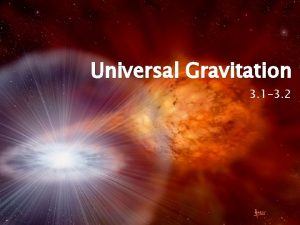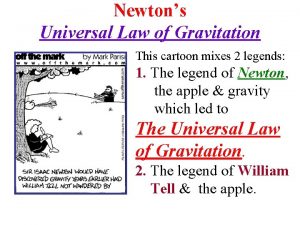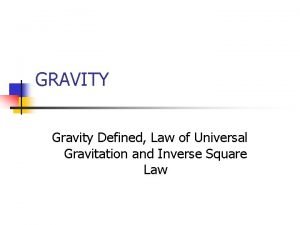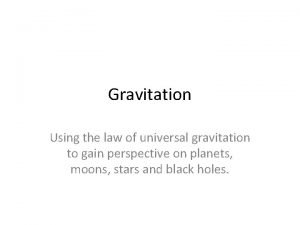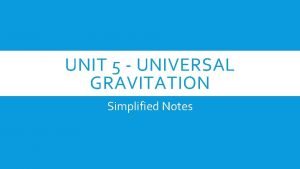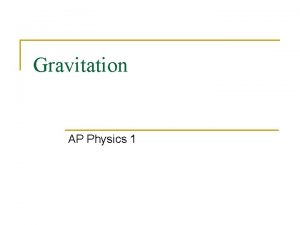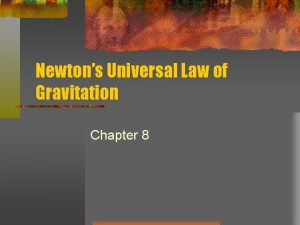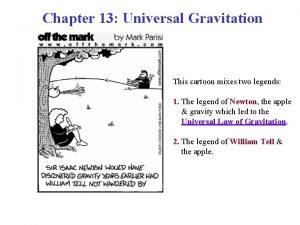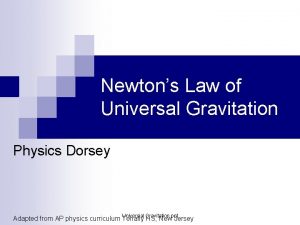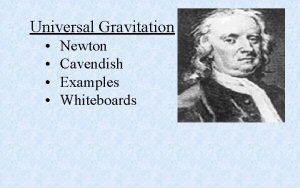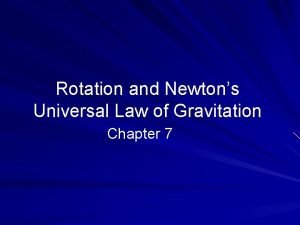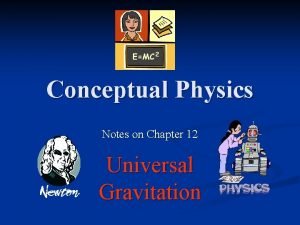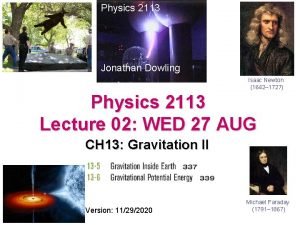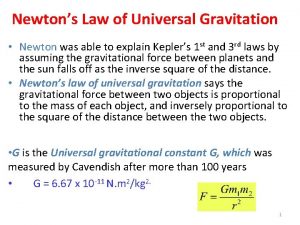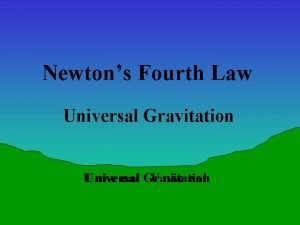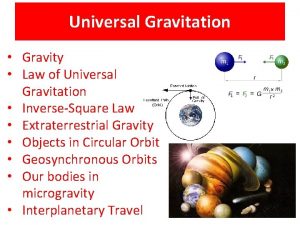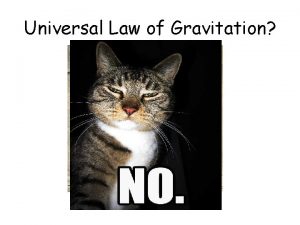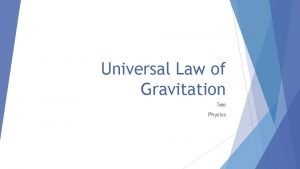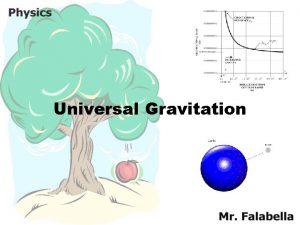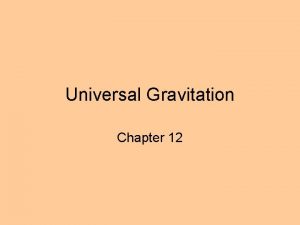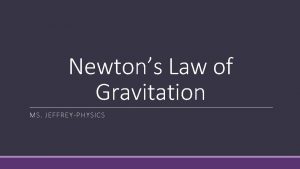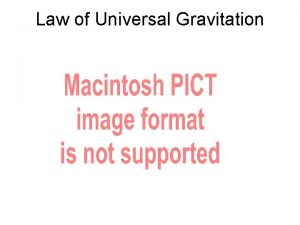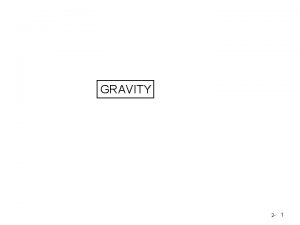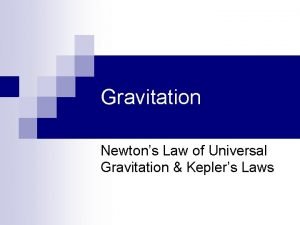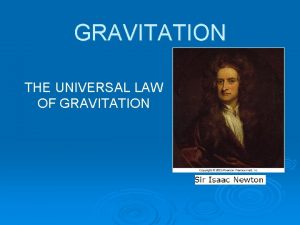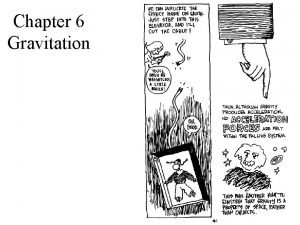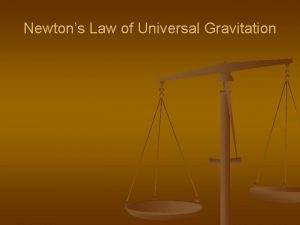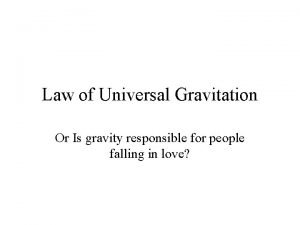Universal Gravitation Gravity Law of Universal Gravitation InverseSquare



















- Slides: 19

Universal Gravitation • Gravity • Law of Universal Gravitation • Inverse-Square Law • Extraterrestrial Gravity • Objects in Circular Orbit • Geosynchronous Orbits • Our bodies in microgravity • Interplanetary Travel

Gravity is everywhere • Gravity is present wherever there is matter • Thus, all material things are exerting a force on all other material things

Law of Universal Gravitation F = Force of gravity between the two objects G = Universal gravitational constant = 6. 67 x 10 -11 Nm 2 kg-2 m 1 and m 2 are the masses of the objects in kg r = distance separating the two objects (center to center)

Inverse squares – 1/r 2 Notice the large increase with each increment

Considerations • Gravity acts between two objects. – Equal forces acting in opposite directions. • Masses must be large to notice a g force – i. e. the Earth doesn’t notice our individual pull on it but we notice its pull on us. This is why you cannot fly • Further apart = smaller force of gravity Never zero. In space we experience very little gravity due to increased distance from any large mass. This is called microgravity.

The Power of G • Extraterrestrial Gravity – Gravitational acceleration on other planets can be calculated using this law, as long as the mass of the planet is known

Extraterrestrial Gravity Planet Radius (m) Mass (kg) g (m/s 2) Mercury 2. 43 x 106 3. 2 x 1023 3. 61 Venus 6. 073 x 106 4. 88 x 1024 8. 83 Mars 3. 38 x 106 6. 42 x 1023 3. 75 Jupiter 6. 98 x 107 1. 901 x 1027 26. 0 Saturn 5. 82 x 107 5. 68 x 1026 11. 2 Uranus 2. 35 x 107 8. 68 x 1025 10. 5 Neptune 2. 27 x 107 1. 03 x 1026 13. 3 Pluto 1. 15 x 106 1. 2 x 1022 0. 61

Check Your Understanding • Earth’s gravitational pull on a spacecraft some distance away is 1. 2 x 102 N in magnitude. What will the magnitude of the force of gravity be on a second spacecraft with 1. 5 times the mass of the first spacecraft, at a distance from Earth’s centre that is 0. 45 times as great? Solution: F 2 = 8. 9 x 102 N

Check Your Understanding • Determine the magnitude of the force of attraction between two uniform metal balls, of mass 4. 00 kg, used in women’s shotputting, when the centres are separated by 45. 0 cm. Solution: F = 5. 27 x 10 -9 N

Objects in Circular Orbit • Objects in space orbit larger masses due to the force of gravity between them. • Then why isn’t an object that is orbiting another in space (i. e. a TV satellite in outer space) simply get pulled down to the surface?

Objects in Circular Orbit • An object in circular orbit (like a satellite) has forward motion but is constantly being pulled by the force of gravity towards Earth. • If the orbiting object maintains its forward motion without changing its distance from Earth, it will continually “fall” around Earth in a circular orbit.

Objects in Circular Orbit • To analyze the motion of objects in circular orbit, we combine Newton’s law of universal gravitation with the equation for centripetal acceleration involving speed. • We can also use our equations for frequency and orbital period

Check Your Understanding • The Hubble Space Telescope (HST) follows an essentially circular orbit, at an average altitude of 598 km above the surface of Earth. G = 6. 67 x 10 -11 Nm 2/kg 2 m. E = 5. 98 x 1024 kg Distance from Earth’s core to the surface = 6. 38 x 106 m a) Determine the speed needed by the HST to maintain its orbit. Express the speed both in metres per second and in kilometers per hour. Solution: v = 7. 56 x 103 m/s & v = 2. 72 x 104 km/h

Geosynchronous Orbits • Special kind of orbit • This means the object stays in the same place relative to the Earth Ø Will always point to the same location • Useful for communication satellites Altitude = 35, 786 km v = 3070 m/s T = 23. 93446 hours

Our bodies in microgravity • The absence of forces against the muscles (caused by microgravity) has significant long-term health consequences – Muscle atrophy – Loss of bone calcium – Organ swelling (heart, kidneys) The ISS does not have artificial gravity

Interplanetary Travel • Currently astronauts have a rigorous exercise regime to limit these effects

Long-term solutions • Any interplanetary mission (to Mars or beyond) or permanent space colony must simulate gravity for the health of participating astronauts/scientists • Can be done using the principals of circular motion

Proposed space colonies

Check Your Understanding A cylindrical space craft travelling to Mars has an interior diameter of 3. 24 km. The craft rotates around its axis at the rate required to give astronauts along the interior wall an apparent weight equal in magnitude to their Earthbound weight. Determine: a) the speed of the astronauts relative to the centre of the spacecraft and b) the period of rotation of the spacecraft. Solutions: a) v = 126 m/s b) T = 80. 8 s
 Explain newton’s universal law of attraction/gravitation.
Explain newton’s universal law of attraction/gravitation. The universal law of gravitation written by isaac
The universal law of gravitation written by isaac تسارع الجاذبية
تسارع الجاذبية Universal gravitation law
Universal gravitation law Tangential speed
Tangential speed Universal gravitation law
Universal gravitation law Universal law of gravitation calculator
Universal law of gravitation calculator Newton's universal law of gravitation ap physics 1
Newton's universal law of gravitation ap physics 1 Newton's universal law of gravitation simplified
Newton's universal law of gravitation simplified Chapter 13 universal gravitation
Chapter 13 universal gravitation Law of universal gravitation ppt
Law of universal gravitation ppt Law of universal gravitation kid definition
Law of universal gravitation kid definition Newton's law of gravitation
Newton's law of gravitation Conceptual physics chapter 13 universal gravitation
Conceptual physics chapter 13 universal gravitation Gravity for dummies and dummies for gravity equations
Gravity for dummies and dummies for gravity equations Gauss theorem
Gauss theorem Newton's law of gravitation
Newton's law of gravitation Newtons 4th law
Newtons 4th law Newton's first law and second law and third law
Newton's first law and second law and third law Newton's first law and second law and third law
Newton's first law and second law and third law
